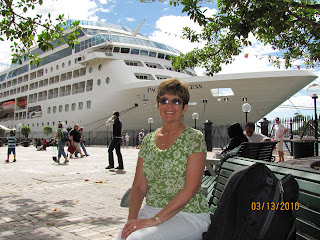
On Monday, March 29, we arrived in the harbor at Nagasaki, Japan. We sailed in under clear skies (although chilly) below a gorgeous suspension bridge. The cruise ship terminal was brand-new, in fact we may have been the first ship to use it as the normally efficient Japanese seemed a bit flummoxed by the new technology (and were determined to use each and every bit of it on us) and the lines to clear immigration were long and slow-moving. The city is tidy, tidy, tidy, with everyone seemingly focused on wherever they are going—no loitering or idleness in sight. We spent the morning marveling at the gardens and the shops. Lots of fantastic things to buy, but the prices were way beyond our willingness to pay. We ended up only buying a few tiny bottles of sake and some postcards and stamps.
In the afternoon we took a tour of the Peace Park and the Atomic Bomb Museum. As you know, Nagasaki was the second—and final—city destroyed by the allies using a nuclear bomb (Hiroshima’s bomb was uranium; Nagasaki’s was plutonium—but the effects were pretty much the same). I was hesitant about going to the atomic bomb site (they also call it “ground zero”) but I was glad I did. The images are horrifying, but it’s our history and I think it’s important to know what happened. The focus at the Peace Park and the Atomic Bomb Museum is to promote lasting world-wide peace. The timeline which shows the events leading up to the bombing of Nagasaki are heart-breaking. This beautiful city wasn’t even on the “short list” of targets until a day or two before the bomb was dropped—and in the end the allies missed their target of the Mitsubishi shipyards by a few miles—but over 150,000 people perished in the blast. Some 70,000 during the blast, and another 80,000 in the five months following (from radiation sickness, burns, hunger and thirst). It must have been hell on earth. The only saving grace is that Japan surrendered and WWII was over. One poignant marker in the Atomic Bomb Museum mentioned that “Japan had been at war for over 15 years prior to the atomic bombing of Nagasaki. Wars with China, Korea, and the Southern Expansion had taken a toll on the country—especially since nearly all able-bodied men were involved in military service. Since the bombing, Japan has enjoyed over five decades of peace” [the plaque was dedicated in 1995].
The entire experience at the Peace Park/Bomb Museum was sobering. You’d think if we can “put a man on the moon” we could find a better way to settle our differences than blast each other to kingdom come.
March 30
Okay, we woke up the next morning and we were in Pusan (or some say “Busan”) Korea. It’s another bustling port, with container ships and tankers everywhere. It’s the second largest city in the country (I noticed that the locals do not make any distinction between North Korea and South Korea—for them, it’s just “Korea”) and the city includes some 3,500,000 residents. We had a short stay here (only about six hours) so we had to hot-foot it off the ship and get into town. We were dismayed to find that the shops didn’t open until about 10am. We were in town just after 8am. So, we did what everyone around the world does when they’ve got to while away a few hours—we went to Starbucks! A few stores opened around nine, so we began wandering around. The shops are amazing. Every little (and I’m talking guest bedroom-size little) shop specializes in a certain type of merchandise (toys, kitchen wares, fabrics, pillows, stationery, backpacks, whatever). And they are all jumbled up. Not even Wal-Mart is this confusing. The shopping is all on tiny alleyways, with motor scooters and tiny trucks zooming up the middle, making us jump for our lives (I almost landed in a huge display of artificial flowers while fleeing a honking mini-truck) every two or three minutes. It’s nuts. We scored a few finds (socks bearing the likeness of President Obama and Tim Tam cookies from Australia) but we never found the truly “good” shopping area we were seeking (where they have the knock-off purses and fake Hermes scarves). Oh well. We’ve been told that U.S. Customs is cracking down on counterfeiting and might take them away anyway.
We are sailing out of the harbor as I write this. So far, the weather has been co-operating with clear, cold days and no rain. Now on to China. It will take a while to get there so you won’t hear from me for a few days. We are landing at Xingang and then we’re taking an overnight trip to Beijing to see the Great Wall and the Forbidden City. We’ll be back onboard on Saturday. I’ll check in then and let you know how well I held up hoofing it up the wall and around the huge squares. I think we are also going to buzz by the Olympic Village. Tom’s excited since they’ve promised us Peking Duck. I’m excited since they’ve promised us we’re staying in a Marriott Hotel. Hey—I’m a “go along to get along” girl, but I have my limits. And a hole in the floor does NOT strike me as a proper excuse for a toilet.



















